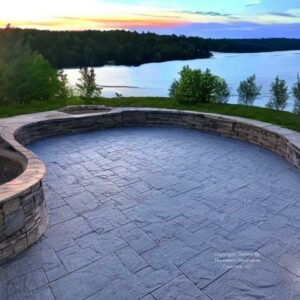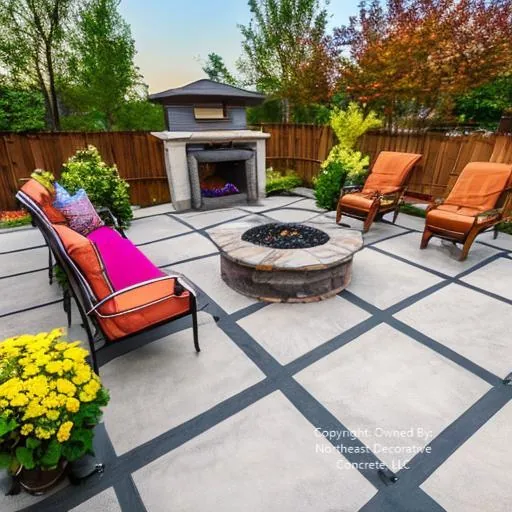
Learn the consequences of not sealing stamped concrete and why it’s important to seal it to protect it from the weather, mold, mildew, and dirt staining elements.
What Happens If I Don’t Seal My Stamped Concrete?
Sealing your stamped concrete is crucial. It protects its appearance and durability over time. This article explains why you need to seal. It also explains what can happen if you don’t. Also, it describes how to choose the best sealer using research and recommendations.
Unsealed decorative concrete surfaces show significant fading within months due to UV exposure. Over time, they can also face permanent staining, mineral deposits, scaling, and pitting damage. Cracking and biological growth are other concerns. This happens as sealers prevent liquid and contaminant penetration.
7 Top Reasons Why You Should Protect Your Concrete Mix!
| Issue | Description |
| Damage from freeze-thaw cycles | Water can penetrate the concrete and cause cracking and pitting when it freezes and thaws. This is especially a problem in colder climates like New England. |
| Fading and discoloration | UV exposure and weathering can cause stamped concrete to fade and lose color over time without a protective sealant. |
| Staining | An unsealed surface allows oil, grease, and other contaminants to soak in and stain the concrete. |
| Mold, mildew, and algae growth | Moisture trapped in the concrete’s pores allows the growth of microorganisms that discolor the surface. |
| Structural damage | Water penetration leads to spalling, crumbling, and compromising the concrete’s strength over time. |
| Slip hazard | Unsealed concrete can get very slick when wet, creating a dangerous slip risk. The sealant creates traction. |
| Efflorescence | Efflorescence refers to white powdery deposits that can appear on cement surfaces. It occurs when moisture within the concrete evaporates, leaving behind mineral salts. Sealing the surface can help prevent efflorescence by reducing moisture absorption into the concrete. |
Why Seal Decorative Concrete?
Concrete is a porous material that absorbs liquids and contaminants over time. Spilling or applying anything to unsealed stamped concrete can stain, etch, pit, crack, or otherwise damage it.
A protective recoating layer for concrete creates a protective barrier that prevents penetration. It also allows moisture vapor to escape.

Benefits of Sealing Concrete:
- Protects against stains, oil, grease, and chemical penetration
- It enhances color vibrancy and provides a more prosperous, deeper appearance
- Adds glossy sheen ranging from satin to high gloss
- Protects against moisture ingress and freeze-thaw damage
- It makes cleaning and maintenance easier
- Extends lifespan by protecting from weathering and wear
- Can restore faded color and appearance in older stained concrete
Sealers prevent the absorption of corrosive substances that erode concrete surfaces over time. They protect from deicing salts, fertilizers, oils, greases, and other contaminants.
What Happens If Stamped Concrete Isn’t Sealed?
Many homeowners choose colored concrete for its decorative, high-end appearance. It reminds them of natural stone or brick materials. But without sealing, the beauty will fade. This happens within the first year. It’s due to staining, erosion, and other deterioration issues.
Here’s what can happen in more detail if colored textured concrete isn’t coated with a protective layer.
- UV rays from sunlight break down the pigments in concrete. This causes it to fade. This happens even faster on horizontal surfaces with direct sun exposure. An unsealed decorative concrete surface can show faded colors within a few months.
- Liquids like wine, oil, grease, and food spills will leave permanent stains. This happens without a protective sealer barrier. Water can leave mineral deposits over time. It penetrates the porous cement surface.
- Deicing salts, fertilizers, acidic cleaners, and other chemicals cause significant surface deterioration in concrete. It happens when concrete absorbs them. This leads to widespread scaling and pitting damage on unsealed concrete projects.
- Water seeping into concrete and freezing causes cracks. It also causes crumbling, pitting, and erosion over time. This especially happens in colder climates—the pressures of ice expansion inside the concrete cause the material to break down.
- Damp concrete is a breeding ground for ugly black or green mold and mildew. Algae and other biological growth also thrive there. A quality sealer prevents moisture absorption and penetration where microorganisms could take root.
- Unsealed cracks and joints in concrete allow weed seeds, dirt, and debris to take root. This can cause ugly staining and physical pressure cracks as vegetation grows.
How Long Does Stamped Concrete Sealers Last?
| Sealer Type | Durability | Features | Best Use Cases |
| Solvent-Based Acrylic | 3-5 years | Enhances color, glossy, resists stains/damage, durable | High-traffic areas |
| Water-Based Acrylic | 1-2 years | Lower VOC, affordable, easy application | General use |
| Penetrating Sealers | 2-5 years | Protects against salt/freeze damage, no high gloss | Low-Medium traffic areas |
On average, most stamped solvent sealers will last 3-5 years before needing reapplication. However, the actual sealer lifespan can vary depending on the following:
- – Type of sealer used
- – Surface wear/abrasion
- – UV light exposure
- – Weather fluctuations
- – Foot/vehicle traffic
- – Number of freeze/thaw cycles
- – Proper prep and application
When Should You Seal Stamped Concrete?
For best durability, protect the stamped concrete surface as soon as possible once fully cured. This happens around 28 days after installation.
Critical timing considerations:
- Allow the concrete to cure for 28+ days before clear coating
- Clear Coat ASAP once the concrete is fully cured
- Seal BEFORE exposing concrete to high traffic, weather, liquids
- Ideal sealing temps are 50-80°F
- If left unsealed for over 60 days, staining and material breakdown speed up

What’s the Best Stamped Concrete Sealer?
All major sealer types can protect and enhance stamped concrete walkways with good prep work. But, solvent-based acrylics provide the longest-lasting protection with the most enhancement.
The higher the solids content in the sealer, the better the sealer is. Look for at least 25% to 30% solids. It helps bring out the colors and vibrancy in the colored concrete surface. The results are profound, beautiful colors.
From my own experience sealing over 500,000 sq. ft. of concrete over 35yrs, the best options include:
Solvent-Based Acrylic
The most popular sealer for decorative concrete. It provides up to 3-5 years of protection while enhancing color. Gloss finish resists fading, stains, salt damage, and resists yellowing. Ideal for high-traffic areas.
Water-Based Acrylic
This lower-odor, VOC-compliant acrylic is suitable for stamped concrete. It would be best if you resealed it every 1 to 2 years. Offers good protection with color enhancement—a more affordable option with easy application.
Penetrating Sealers
Soak into concrete pores without leaving a surface gloss. Protect against salt/freeze damage. Need frequent reapplication. Best for low-traffic areas. We recommend resealing every 2-5 years.
Always check the manufacturer’s recommendations for the best sealer. Consider your climate and project specifications.
What Happens If I Don’t Reseal My Stamped Concrete?
Unsealed concrete can lose over 40% of its color in 12-24 months. Restoring this fade with a significantly more costly expense would be best.
You can’t remove all the staining in most cases.
– Surface erosion that requires costly repairs
– Growth of mold, mildew, weeds
The sealed protective layer prevents increased surface damage, cracks, and deterioration. Without the layer, moisture can penetrate—freeze-thaw cycles and foot or vehicle traffic cause abrasion.
Check your concrete sealer every 6-12 months for fading. Reseal at the first signs of wear before permanent damage occurs.
Conclusion – Protect Your Investment!
Follow these research-backed tips to keep your colored concrete looking beautiful for decades.
– Seal stamped concrete within 28 days of installation
– Reseal Solvent-based every 3-5 years, Water-based every 1-2 years, and penetrating every 2-5 years
– Address sealer issues ASAP to prevent permanent damage
– Choose quality solvent-based acrylic sealer
Maintaining your textured concrete takes minimal effort. But, skipping proper clear coatings can lead to hazardous conditions. It can also cause ugly discoloration and costly repairs. Protect your investment with informed sealing and care!
FAQs:
Q: Is it okay Not to Seal Colored Exterior Concrete?
A: Leaving textured concrete unsealed is not advisable. Sealing is vital to maintain its appearance and protect it from staining, fading, cracking erosion, and other damage that can occur over time. Without a protective sealer, colored concrete floors will deteriorate, losing their aesthetic appeal and monetary value. Therefore, applying a protective sealer barrier is crucial to preserve the integrity and longevity of textured concrete surfaces.
Q: Will Sealing Concrete Change Its Appearance?
A: Sealing concrete can indeed alter its appearance to some extent. While the exact changes may vary based on factors like the type of sealer used and the condition of the concrete, sealing generally enhances the color and gloss of the surface. Additionally, it can provide a more uniform appearance by reducing the visibility of imperfections and enhancing the overall aesthetics. However, it is essential to note that specific effects of sealing too much on concrete surfaces may differ depending on the sealer product and individual circumstances.
Q: How Often do You have to Reseal a Solvent Concrete Driveway?
A:
- Solvent-based sealers: Reapply every 3-5 yrs.
- Water-based sealers: Reapply every 1-2 yrs.
- Penetrating sealers: Reapply every 2-5 yrs.
Q: Does Unsealed Concrete Pose a Safety Risk?
A: Unsealed concrete patios allow liquids to penetrate, leading to potential freeze-thaw damage, weathering, and contamination. These factors can result in various issues, such as cracking, crumbling, erosion, and the growth of mold and mildew on the cement surface. Additionally, color fading and other forms of deterioration may occur. Moreover, unsealed concrete poses safety hazards such as trip hazards and increased risk of slipping. Without a protective barrier, concrete also loses its aesthetic appeal and depreciates over time
Our Locations:
Nashua, NH
North Hampton, NH
Concord, NH

